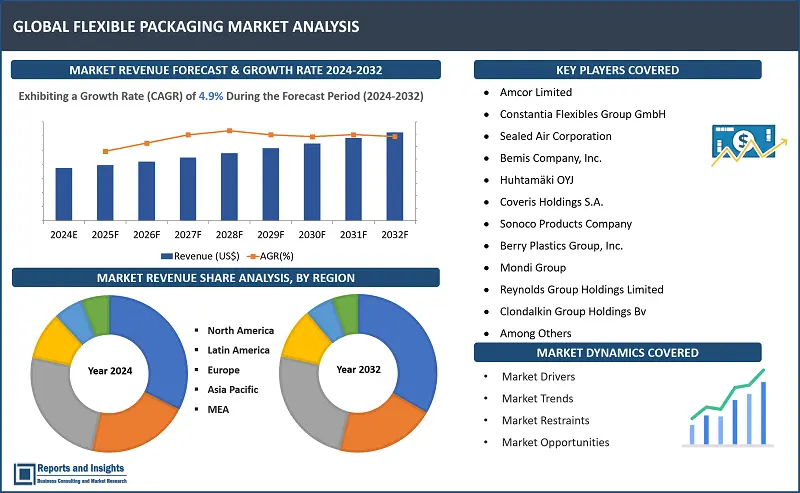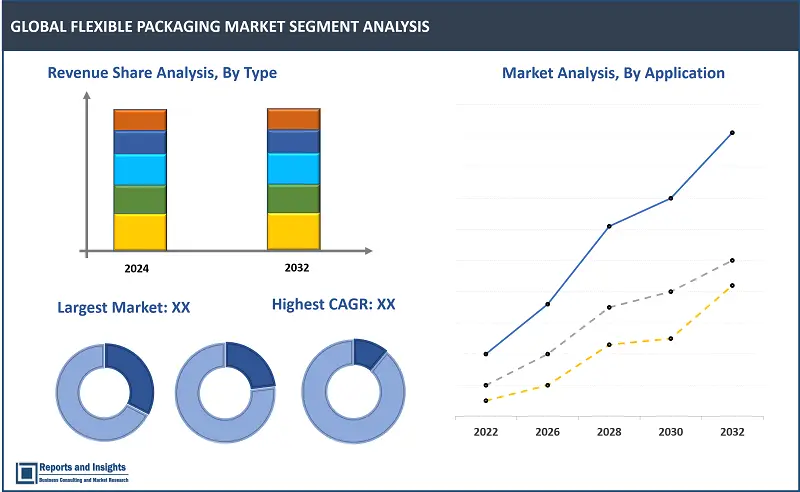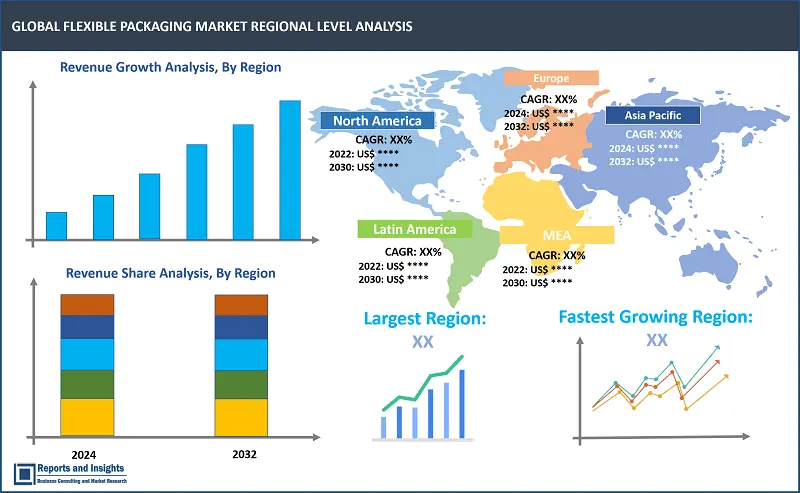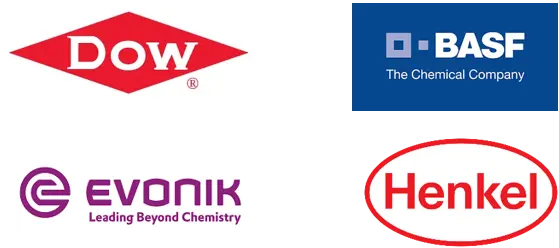Market Overview:
"The global flexible packaging market size reached US$ 261.1 billion in 2023. Looking forward, Reports and Insights expects the market to reach US$ 401.6 billion in 2032, exhibiting a growth rate (CAGR) of 4.9% during 2024-2032."
|
Report Attributes |
Details |
|
Base Year |
2023 |
|
Forecast Years |
2024-2032 |
|
Historical Years |
2021-2023 |
|
Market Growth Rate (2024-2032) |
4.9% |
Flexible packaging is a form of packaging made from materials like plastic, paper, or foil that can be easily shaped or formed. It's used for products needing protection against moisture, oxygen, and light. This type of packaging is versatile, coming in different shapes and sizes, and is suitable for various products such as food, beverages, pharmaceuticals, and personal care items. It's lightweight, cost-effective, and often more environmentally friendly than rigid packaging.
The global flexible packaging market is thriving, fueled by factors like growing demand for convenient packaging, shifts in consumer lifestyles, and the expansion of e-commerce. This type of packaging is favored for its lightweight properties, cost-effectiveness, and eco-friendliness compared to rigid packaging. The industry is marked by ongoing innovation, as companies work to create new materials and technologies that cater to changing consumer and industry demands.

Flexible Packaging Market Trends and Drivers:
The flexible packaging market is influenced by several key trends and drivers. One notable trend is the increasing demand for environmentally friendly packaging solutions, spurred by growing environmental awareness. Both consumers and regulatory bodies are advocating for packaging materials that can be recycled, reused, or composted. Another significant driver is the expansion of e-commerce, which has created a greater need for packaging that not only protects products but also enhances their visual appeal and ease of opening. Additionally, there is a rising preference for convenience among consumers, who are seeking packaging that is lightweight, portable, and easy to store. These trends are stimulating innovation in the flexible packaging industry, leading to the introduction of new materials and technologies to meet the changing demands of consumers and markets.
Flexible Packaging Market Restraining Factors:
Several factors can hinder the growth of the flexible packaging market. One significant challenge is the environmental impact associated with flexible packaging materials, especially single-use plastics. This has led to increased regulations and scrutiny aimed at reducing plastic waste. Fluctuating raw material prices can also impact the cost-effectiveness of flexible packaging, affecting manufacturers' profit margins. Additionally, competition from alternative packaging solutions, such as rigid packaging or sustainable options like glass or metal, poses a challenge. Furthermore, the complex nature of recycling flexible packaging materials, due to their multilayered structures, presents a barrier to achieving high recycling rates. These factors, among others, can impede the expansion and progress of the flexible packaging market.
Flexible Packaging Market Opportunities:
The flexible packaging market is ripe with opportunities for expansion and innovation. One promising area is the development of sustainable packaging solutions, including bio-based and recyclable materials, to meet the growing demand for eco-friendly packaging. Another opportunity lies in penetrating emerging markets, where increasing disposable incomes and evolving consumer preferences are creating a greater need for packaged products. Advancements in technology, such as digital printing and smart packaging, also offer avenues for customization and interactive packaging solutions. Furthermore, the rise of e-commerce presents a unique opportunity for the flexible packaging market, as online retailers seek packaging that is not only protective but also cost-effective and visually appealing. These opportunities are poised to drive growth and advancement in the flexible packaging sector in the foreseeable future.
Flexible Packaging Market Segmentation:

By Type
- Stand-Up Pouches
- Flat Pouches
- Rollstocks
- Gusseted Bags
- Wicketed Bags
- Wraps
- Others
Stand-up pouches are currently the dominant sub-segment in the flexible packaging market. They are preferred for their convenience, light weight, and ability to showcase products attractively on retail shelves. Stand-up pouches offer advantages such as resealability, longer shelf life, and suitability for a wide range of products like food, beverages, and personal care items. Their popularity is driven by consumer demand for convenience and portability, as well as their environmentally friendly features compared to traditional packaging. Therefore, stand-up pouches are expected to maintain their leading position in the flexible packaging market in the foreseeable future.
By Material
- Plastic Films
- Biaxially Oriented Poly Propylene
- Cast Polypropylene
- High-Density Polyethylene
- Low-Density Polyethylene
- Paper
- Aluminum Foil
- Bioplastics
Plastic films currently lead the flexible packaging market. They are popular for their flexibility, durability, and cost-effectiveness. These films provide strong barriers against moisture, oxygen, and light, making them suitable for various products like food, beverages, pharmaceuticals, and personal care items. Additionally, plastic films are lightweight and offer easy customization through printing, allowing for appealing packaging designs. Despite environmental concerns, plastic films remain widely used in flexible packaging due to their functional benefits and affordability.
By Printing Technology
- Flexography
- Rotogravure
- Digital Printing
- Other
Flexography stands out as the leading printing technology in the flexible packaging market. Its popularity is driven by its versatility, cost-effectiveness, and capacity to print on various substrates like film, paper, and foil. Flexographic printing excels in high-volume printing, delivering excellent print quality suitable for vibrant colors and intricate designs. Its quick drying times and high-speed capabilities further enhance its appeal in the flexible packaging sector. While digital printing is emerging for its customization and suitability for short print runs, flexography remains the go-to choose for many manufacturers due to its reliability and cost efficiency, especially for large-scale production
By Application
- Food Beverage
- Healthcare
- Cosmetics Toiletries
- Other Applications
The food and beverage industry stands out as the dominant application segment in the flexible packaging market. This is due to the extensive use of flexible packaging in providing barrier protection, convenience, and visually appealing product presentation. Flexible packaging plays a crucial role in the food industry by extending shelf life, preserving product freshness, and reducing food waste. In the beverage sector, it offers lightweight and easily portable packaging solutions. While flexible packaging also finds wide applications in healthcare, cosmetics, and toiletries, its prevalence in the food and beverage industry is particularly noteworthy due to the sector's high demand for flexible, cost-effective, and sustainable packaging solutions.
By Region

North America
- United States
- Canada
Europe
- Germany
- United Kingdom
- France
- Italy
- Spain
- Russia
- Poland
- Benelux
- Nordic
- Rest of Europe
Asia Pacific
- China
- Japan
- India
- South Korea
- ASEAN
- Australia & New Zealand
- Rest of Asia Pacific
Latin America
- Brazil
- Mexico
- Argentina
Middle East & Africa
- Saudi Arabia
- South Africa
- United Arab Emirates
- Israel
- Rest of MEA
The Asia Pacific region is currently the dominant region in the flexible packaging market. This growth is fueled by rapid urbanization, evolving consumer habits, and rising disposable incomes. The food and beverage sector is a major contributor to this trend, alongside healthcare and personal care industries. Moreover, technological advancements and material innovations are further propelling the packaging industry in the region. While North America and Europe remain substantial markets for flexible packaging, it is the Asia Pacific region that leads, driven by its expansive consumer market and flourishing industries.
Leading Flexible Packaging Manufacturers & Competitive Landscape:
The flexible packaging market is highly competitive, with several key players vying for market share and actively engaging in strategic initiatives. These companies focus on product innovation, technological advancements, and expanding their product portfolios to gain a competitive edge. These companies are continuously investing in research and development activities to enhance their product offerings and cater to the evolving needs of customers in terms of efficiency, performance, and sustainability.
These companies include:
- Amcor Limited
- Constantia Flexibles Group GmbH
- Sealed Air Corporation
- Bemis Company, Inc.
- Huhtamäki OYJ
- Coveris Holdings S.A.
- Sonoco Products Company
- Berry Plastics Group, Inc.
- Mondi Group
- Reynolds Group Holdings Limited
- Clondalkin Group Holdings Bv
- Novolex – Carlyle Group
- Bischof + Klein SE & Co. Kg
- British Polythene Industries PLC (RPC BPI Group)
- Proampac
- Britton Group Limited
Flexible Packaging Market Research Scope:
|
Report Metric |
Report Details |
|
Market size available for the years |
2021-2023 |
|
Base Year |
2023 |
|
Forecast Period |
2024-2032 |
|
Compound Annual Growth Rate (CAGR) |
4.9% |
|
Segment covered |
Type, material, printing technology, applications and regions. |
|
Regions Covered |
North America: The U.S. Canada Latin America: Brazil, Mexico, Argentina, & Rest of Latin America Asia Pacific: China, India, Japan, Australia New Zealand, ASEAN, Rest of Asia Pacific Europe: Germany, The U.K., France, Spain, Italy, Russia, Poland, BENELUX, NORDIC, Rest of Europe The Middle East Africa: Saudi Arabia, United Arab Emirates, South Africa, Egypt, Israel, and Rest of MEA |
|
Fastest Growing Country in Europe |
Germany |
|
Largest Market |
North America |
|
Key Players |
Amcor Limited, Constantia Flexibles Group GmbH, Sealed Air Corporation, Bemis Company, Inc., Huhtamäki OYJ, Coveris Holdings S.A., Sonoco Products Company, Berry Plastics Group, Inc., Mondi Group, Reynolds Group Holdings Limited, Clondalkin Group Holdings Bv, Novolex – Carlyle Group, Bischof + Klein SE & Co. Kg, British Polythene Industries PLC (RPC BPI Group), Proampac and Britton Group Limited. |
1. Global Flexible Packaging Market Report Overview
1.1. Introduction
1.2. Report Description
1.3. Methodology
2. Global Flexible Packaging Market Overview
2.1. Introduction
2.1.1. Introduction
2.1.2. Market Taxonomy
2.2. Executive Summary
2.3. Global Flexible Packaging Market Snapshot
2.4. Global Flexible Packaging Market Size and Forecast, 2020–2028
2.4.1. Introduction
2.4.2. Market Value Forecast and Annual Growth Rate (AGR) Comparison (2020–2028)
2.5. Global Flexible Packaging Market Dynamics
2.5.1. Drivers
2.5.2. Restraints
2.5.3. Opportunity
2.5.4. Trends
2.6. Key Regulations
2.7. Porter’s Five Forces Model
3. Global Flexible Packaging Market, By Type
3.1. Introduction
3.1.1. Annual Growth Rate Comparison, By Type
3.1.2. BPS Analysis, By Type
3.2. Market Revenue (US$Mn) Forecast, By Type
3.2.1. Stand-Up Pouches
3.2.1.1. Standard Stand-Up Pouches
3.2.1.2. Retort Stand-Up Pouches
3.2.2. Flat Pouches
3.2.2.1. Standard Flat Pouches
3.2.2.2. Retort Flat Pouches
3.2.3. Rollstocks
3.2.4. Gusseted Bags
3.2.5. Wicketed Bags
3.2.6. Wraps
3.2.7. Others
3.3. Global Flexible Packaging Market Attractiveness Index, By Type
4. Global Flexible Packaging Market, By Material
4.1. Introduction
4.1.1. Annual Growth Rate Comparison, By Material
4.1.2. BPS Analysis, By Material
4.2. Market Revenue (US$Mn) Forecast, By Material
4.2.1. Plastic Films
4.2.1.1. Polypropylene
4.2.1.1.1. Biaxially Oriented Poly Propylene
4.2.1.1.2. Cast Polypropylene
4.2.1.2. Polyethylene
4.2.1.2.1. High-Density Polyethylene
4.2.1.2.2. Low-Density Polyethylene
4.2.1.3. Poly Vinyl Chloride
4.2.1.4. Biaxiallyoriented Polyethylene Terephthalate
4.2.1.5. Ethylene Vinyl Alcohol
4.2.1.6. Polyamide
4.2.1.7. Polystyrene
4.2.2. Paper
4.2.3. Aluminum Foil
4.2.4. Bioplastics
4.3. Global Flexible Packaging Market Attractiveness Index, By Material
5. Global Flexible Packaging Market, By Printing Technology
5.1. Introduction
5.1.1. Annual Growth Rate Comparison, By Printing Technology
5.1.2. BPS Analysis, By Printing Technology
5.2. Market Revenue (US$Mn) Forecast, By Printing Technology
5.2.1. Flexography
5.2.2. Rotogravure
5.2.3. Digital Printing
5.2.4. Other
5.3. Global Flexible Packaging Market Attractiveness Index, By Printing Technology
6. Global Flexible Packaging Market, By Application
6.1. Introduction
6.1.1. Annual Growth Rate Comparison, By Application
6.1.2. BPS Analysis, By Application
6.2. Market Revenue (US$Mn) Forecast, By Application
6.2.1. Food & Beverage
6.2.2. Healthcare
6.2.3. Cosmetics & Toiletries
6.2.4. Other Applications
6.3. Global Flexible Packaging Market Attractiveness Index, By Application
7. Global Flexible Packaging Market, By Region
7.1. Introduction
7.1.1. Annual Growth Rate Comparison, By Region
7.1.2. BPS Analysis, By Region
7.2. Market Revenue (US$Mn) Forecast, By Region
7.2.1. North America
7.2.2. Latin America
7.2.3. Europe
7.2.4. Asia Pacific
7.2.5. Middle East
7.2.6. Africa
7.3. Global Flexible Packaging Market Attractiveness Index, By Region
8. North America Flexible Packaging Market Analysis and Forecast, 2020–2028
8.1. Introduction
8.1.1. Annual Growth Rate Comparison, By Country
8.1.2. BPS Analysis, By Country
8.2. Flexible Packaging Market (US$Mn) Value Forecast, By Country
8.2.1. U.S. Flexible Packaging Market
8.2.2. Canada Flexible Packaging Market
8.3. North America Flexible Packaging Market, By Type
8.3.1. Stand-Up Pouches
8.3.1.1. Standard Stand-Up Pouches
8.3.1.2. Retort Stand-Up Pouches
8.3.2. Flat Pouches
8.3.2.1. Standard Flat Pouches
8.3.2.2. Retort Flat Pouches
8.3.3. Rollstocks
8.3.4. Gusseted Bags
8.3.5. Wicketed Bags
8.3.6. Wraps
8.3.7. Others
8.4. North America Flexible Packaging Market, By Material
8.4.1. Plastic Films
8.4.1.1. Polypropylene
8.4.1.1.1. Biaxially Oriented Poly Propylene
8.4.1.1.2. Cast Polypropylene
8.4.1.2. Polyethylene
8.4.1.2.1. High-Density Polyethylene
8.4.1.2.2. Low-Density Polyethylene
8.4.2. Poly Vinyl Chloride
8.4.2.1. Biaxiallyoriented Polyethylene Terephthalate
8.4.2.2. Ethylene Vinyl Alcohol
8.4.2.3. Polyamide
8.4.2.4. Polystyrene
8.4.3. Paper
8.4.4. Aluminum Foil
8.4.5. Bioplastics
8.5. North America Flexible Packaging Market, By Printing Technology
8.5.1. Flexography
8.5.2. Rotogravure
8.5.3. Digital Printing
8.5.4. Other
8.6. North America Flexible Packaging Market, By Application
8.6.1. Food & Beverage
8.6.2. Healthcare
8.6.3. Cosmetics & Toiletries
8.6.4. Other Applications
8.7. North America Flexible Packaging Market Attractiveness Index
8.7.1. By Country
8.7.2. By Type
8.7.3. By Material
8.7.4. By Printing Technology
8.7.5. By Application
9. Latin America Flexible Packaging Market Analysis and Forecast, 2020–2028
9.1. Introduction
9.1.1. Annual Growth Rate Comparison, By Country
9.1.2. BPS Analysis, By Country
9.2. Flexible Packaging Market (US$Mn) Value Forecast, By Country
9.2.1. Brazil Flexible Packaging Market
9.2.2. Mexico Flexible Packaging Market
9.2.3. Argentina Flexible Packaging Market
9.2.4. Rest of Latin America Flexible Packaging Market
9.3. Latin America Flexible Packaging Market, By Type
9.3.1. Stand-Up Pouches
9.3.1.1. Standard Stand-Up Pouches
9.3.1.2. Retort Stand-Up Pouches
9.3.2. Flat Pouches
9.3.2.1. Standard Flat Pouches
9.3.2.2. Retort Flat Pouches
9.3.3. Rollstocks
9.3.4. Gusseted Bags
9.3.5. Wicketed Bags
9.3.6. Wraps
9.3.7. Others
9.4. Latin America Flexible Packaging Market, By Material
9.4.1. Plastic Films
9.4.1.1. Polypropylene
9.4.1.1.1. Biaxially Oriented Poly Propylene
9.4.1.1.2. Cast Polypropylene
9.4.1.2. Polyethylene
9.4.1.2.1. High-Density Polyethylene
9.4.1.2.2. Low-Density Polyethylene
9.4.2. Poly Vinyl Chloride
9.4.2.1. Biaxiallyoriented Polyethylene Terephthalate
9.4.2.2. Ethylene Vinyl Alcohol
9.4.2.3. Polyamide
9.4.2.4. Polystyrene
9.4.3. Paper
9.4.4. Aluminum Foil
9.4.5. Bioplastics
9.5. Latin America Flexible Packaging Market, By Printing Technology
9.5.1. Flexography
9.5.2. Rotogravure
9.5.3. Digital Printing
9.5.4. Other
9.6. Latin America Flexible Packaging Market, By Application
9.6.1. Food & Beverage
9.6.2. Healthcare
9.6.3. Cosmetics & Toiletries
9.6.4. Other Applications
9.7. Latin America Flexible Packaging Market Attractiveness Index
9.7.1. By Country
9.7.2. By Type
9.7.3. By Material
9.7.4. By Printing Technology
9.7.5. By Application
10. Europe Flexible Packaging Market Analysis and Forecast, 2020–2028
10.1. Introduction
10.1.1. Annual Growth Rate Comparison, By Country
10.1.2. BPS Analysis, By Country
10.2. Flexible Packaging Market (US$Mn) Value Forecast, By Country
10.2.1. U.K. Flexible Packaging Market
10.2.2. Germany Flexible Packaging Market
10.2.3. Italy Flexible Packaging Market
10.2.4. France Flexible Packaging Market
10.2.5. Spain Flexible Packaging Market
10.2.6. Russia Flexible Packaging Market
10.2.7. Poland Flexible Packaging Market
10.2.8. BENELUX Flexible Packaging Market
10.2.9. NORDIC Flexible Packaging Market
10.2.10. Rest of Europe Flexible Packaging Market
10.3. Europe Flexible Packaging Market, By Type
10.3.1. Stand-Up Pouches
10.3.1.1. Standard Stand-Up Pouches
10.3.1.2. Retort Stand-Up Pouches
10.3.2. Flat Pouches
10.3.2.1. Standard Flat Pouches
10.3.2.2. Retort Flat Pouches
10.3.3. Rollstocks
10.3.4. Gusseted Bags
10.3.5. Wicketed Bags
10.3.6. Wraps
10.3.7. Others
10.4. Europe Flexible Packaging Market, By Material
10.4.1. Plastic Films
10.4.1.1. Polypropylene
10.4.1.1.1. Biaxially Oriented Poly Propylene
10.4.1.1.2. Cast Polypropylene
10.4.1.2. Polyethylene
10.4.1.2.1. High-Density Polyethylene
10.4.1.2.2. Low-Density Polyethylene
10.4.2. Poly Vinyl Chloride
10.4.2.1. Biaxiallyoriented Polyethylene Terephthalate
10.4.2.2. Ethylene Vinyl Alcohol
10.4.2.3. Polyamide
10.4.2.4. Polystyrene
10.4.3. Paper
10.4.4. Aluminum Foil
10.4.5. Bioplastics
10.5. Europe Flexible Packaging Market, By Printing Technology
10.5.1. Flexography
10.5.2. Rotogravure
10.5.3. Digital Printing
10.5.4. Other
10.6. Europe Flexible Packaging Market, By Application
10.6.1. Food & Beverage
10.6.2. Healthcare
10.6.3. Cosmetics & Toiletries
10.6.4. Other Applications
10.7. Europe Flexible Packaging Market Attractiveness Index
10.7.1. By Country
10.7.2. By Type
10.7.3. By Material
10.7.4. By Printing Technology
10.7.5. By Application
11. Asia Pacific Flexible Packaging Market Analysis and Forecast, 2020–2028
11.1. Introduction
11.1.1. Annual Growth Rate Comparison, By Country
11.1.2. BPS Analysis, By Country
11.2. Flexible Packaging Market (US$Mn) Value Forecast, By Country
11.2.1. China Flexible Packaging Market
11.2.2. India Flexible Packaging Market
11.2.3. Japan Flexible Packaging Market
11.2.4. Australia and New Zealand Flexible Packaging Market
11.2.5. South Korea Flexible Packaging Market
11.2.6. ASEAN Flexible Packaging Market
11.2.7. Rest of Asia Pacific Flexible Packaging Market
11.3. Asia Pacific Flexible Packaging Market, By Type
11.3.1. Stand-Up Pouches
11.3.1.1. Standard Stand-Up Pouches
11.3.1.2. Retort Stand-Up Pouches
11.3.2. Flat Pouches
11.3.2.1. Standard Flat Pouches
11.3.2.2. Retort Flat Pouches
11.3.3. Rollstocks
11.3.4. Gusseted Bags
11.3.5. Wicketed Bags
11.3.6. Wraps
11.3.7. Others
11.4. Asia Pacific Flexible Packaging Market, By Material
11.4.1. Plastic Films
11.4.1.1. Polypropylene
11.4.1.1.1. Biaxially Oriented Poly Propylene
11.4.1.1.2. Cast Polypropylene
11.4.1.2. Polyethylene
11.4.1.2.1. High-Density Polyethylene
11.4.1.2.2. Low-Density Polyethylene
11.4.2. Poly Vinyl Chloride
11.4.2.1. Biaxiallyoriented Polyethylene Terephthalate
11.4.2.2. Ethylene Vinyl Alcohol
11.4.2.3. Polyamide
11.4.2.4. Polystyrene
11.4.3. Paper
11.4.4. Aluminum Foil
11.4.5. Bioplastics
11.5. Asia Pacific Flexible Packaging Market, By Printing Technology
11.5.1. Flexography
11.5.2. Rotogravure
11.5.3. Digital Printing
11.5.4. Other
11.6. Asia Pacific Flexible Packaging Market, By Application
11.6.1. Food & Beverage
11.6.2. Healthcare
11.6.3. Cosmetics & Toiletries
11.6.4. Other Applications
11.7. Asia Pacific Flexible Packaging Market Attractiveness Index
11.7.1. By Country
11.7.2. By Type
11.7.3. By Material
11.7.4. By Printing Technology
11.7.5. By Application
12. Middle East Flexible Packaging Market Analysis and Forecast, 2020–2028
12.1. Introduction
12.1.1. Annual Growth Rate Comparison, By Country
12.1.2. BPS Analysis, By Country
12.2. Flexible Packaging Market (US$Mn) Value Forecast, By Country
12.2.1. GCC Countries Flexible Packaging Market
12.2.2. Israel Flexible Packaging Market
12.2.3. Oman Flexible Packaging Market
12.2.4. Rest of Middle East Flexible Packaging Market
12.3. Middle East Flexible Packaging Market, By Type
12.3.1. Stand-Up Pouches
12.3.1.1. Standard Stand-Up Pouches
12.3.1.2. Retort Stand-Up Pouches
12.3.2. Flat Pouches
12.3.2.1. Standard Flat Pouches
12.3.2.2. Retort Flat Pouches
12.3.3. Rollstocks
12.3.4. Gusseted Bags
12.3.5. Wicketed Bags
12.3.6. Wraps
12.3.7. Others
12.4. Middle East Flexible Packaging Market, By Material
12.4.1. Plastic Films
12.4.1.1. Polypropylene
12.4.1.1.1. Biaxially Oriented Poly Propylene
12.4.1.1.2. Cast Polypropylene
12.4.1.2. Polyethylene
12.4.1.2.1. High-Density Polyethylene
12.4.1.2.2. Low-Density Polyethylene
12.4.2. Poly Vinyl Chloride
12.4.2.1. Biaxiallyoriented Polyethylene Terephthalate
12.4.2.2. Ethylene Vinyl Alcohol
12.4.2.3. Polyamide
12.4.2.4. Polystyrene
12.4.3. Paper
12.4.4. Aluminum Foil
12.4.5. Bioplastics
12.5. Middle East Flexible Packaging Market, By Printing Technology
12.5.1. Flexography
12.5.2. Rotogravure
12.5.3. Digital Printing
12.5.4. Other
12.6. Middle East Flexible Packaging Market, By Application
12.6.1. Food & Beverage
12.6.2. Healthcare
12.6.3. Cosmetics & Toiletries
12.6.4. Other Applications
12.7. Middle East Flexible Packaging Market Attractiveness Index
12.7.1. By Country
12.7.2. By Type
12.7.3. By Material
12.7.4. By Printing Technology
12.7.5. By Application
13. Africa Flexible Packaging Market Analysis and Forecast, 2020–2028
13.1. Introduction
13.1.1. Annual Growth Rate Comparison, By Country
13.1.2. BPS Analysis, By Country
13.2. Flexible Packaging Market (US$Mn) Value Forecast, By Country
13.2.1. South Africa Flexible Packaging Market
13.2.2. Egypt Flexible Packaging Market
13.2.3. North Africa Flexible Packaging Market
13.2.4. Rest of Africa Flexible Packaging Market
13.3. Africa Flexible Packaging Market, By Type
13.3.1. Stand-Up Pouches
13.3.1.1. Standard Stand-Up Pouches
13.3.1.2. Retort Stand-Up Pouches
13.3.2. Flat Pouches
13.3.2.1. Standard Flat Pouches
13.3.2.2. Retort Flat Pouches
13.3.3. Rollstocks
13.3.4. Gusseted Bags
13.3.5. Wicketed Bags
13.3.6. Wraps
13.3.7. Others
13.4. Africa Flexible Packaging Market, By Material
13.4.1. Plastic Films
13.4.1.1. Polypropylene
13.4.1.1.1. Biaxially Oriented Poly Propylene
13.4.1.1.2. Cast Polypropylene
13.4.1.2. Polyethylene
13.4.1.2.1. High-Density Polyethylene
13.4.1.2.2. Low-Density Polyethylene
13.4.2. Poly Vinyl Chloride
13.4.2.1. Biaxiallyoriented Polyethylene Terephthalate
13.4.2.2. Ethylene Vinyl Alcohol
13.4.2.3. Polyamide
13.4.2.4. Polystyrene
13.4.3. Paper
13.4.4. Aluminum Foil
13.4.5. Bioplastics
13.5. Africa Flexible Packaging Market, By Printing Technology
13.5.1. Flexography
13.5.2. Rotogravure
13.5.3. Digital Printing
13.5.4. Other
13.6. Africa Flexible Packaging Market, By Application
13.6.1. Food & Beverage
13.6.2. Healthcare
13.6.3. Cosmetics & Toiletries
13.6.4. Other Applications
13.7. Africa Flexible Packaging Market Attractiveness Index
13.7.1. By Country
13.7.2. By Type
13.7.3. By Material
13.7.4. By Printing Technology
13.7.5. By Application
14. Recommendation
14.1. Market Strategy
15. Competitive Landscape
15.1. Competition Dashboard
15.2. List and Company Overview of Global Key Players
15.3. Company Profiles
15.3.1. Amcor Limited
15.3.1.1. Company Overview
15.3.1.2. Financial Overview
15.3.1.3. Product Portfolio
15.3.1.4. Key Developments
15.3.1.5. Business Strategies
15.3.2. Constantia Flexibles Group GmbH
15.3.3. Sealed Air Corporation
15.3.4. Bemis Company, Inc.
15.3.5. Huhtamäki OYJ
15.3.6. Coveris Holdings S.A.
15.3.7. Sonoco Products Company
15.3.8. Berry Plastics Group, Inc.
15.3.9. Mondi Group
15.3.10. Reynolds Group Holdings Limited
15.3.11. Clondalkin Group Holdings Bv
15.3.12. Novolex – Carlyle Group
15.3.13. Bischof + Klein SE & Co. Kg
15.3.14. British Polythene Industries PLC (RPC BPI Group)
15.3.15. Proampac
15.3.16. Britton Group Limited
16. Acronyms
Frequently Asked Question
At what CAGR will the flexible packaging market expand?
The market is anticipated to rise at 4.9% through 2032.
What are some key factors driving revenue growth of the flexible packaging market?
Some key factors driving flexible packaging market revenue growth includes consumer preferences, regulatory environment, innovation, cost-effectiveness, and sustainability.
What are some major challenges faced by companies in the flexible packaging market?
Companies face challenges such as supply chain disruptions, consumer preferences, raw material costs, environment concerns, and regulatory compliance.
What types of products are commonly packaged in flexible packaging?
Flexible packaging is used to package a wide range of products, including snacks, beverages, pet food, pharmaceuticals, personal care items, and household products.
How is flexible packaging printed?
Flexible packaging can be printed using various printing technologies, including flexography, rotogravure, and digital printing. Each printing method offers different advantages in terms of print quality, speed, and cost.
Is flexible packaging recyclable?
The recyclability of flexible packaging depends on the materials used. While some flexible packaging materials, such as certain plastics and papers, are recyclable, others may not be. It's essential to check with local recycling facilities for specific guidelines.
How is the competitive landscape in the flexible packaging market?
The market is competitive, with key players focusing on technological advancements, product innovation, and strategic partnerships. Factors such as product quality, reliability, after-sales services, and customization capabilities play a significant role in determining competitiveness.
Who are the leading key players in flexible packaging market?
The leading key players in the flexible packaging market are Amcor Limited, Constantia Flexibles Group GmbH, Sealed Air Corporation, Bemis Company, Inc., Huhtamäki OYJ, Coveris Holdings S.A., Sonoco Products Company, Berry Plastics Group, Inc., Mondi Group, Reynolds Group Holdings Limited, Clondalkin Group Holdings Bv, Novolex – Carlyle Group, Bischof + Klein SE & Co. Kg, British Polythene Industries PLC (RPC BPI Group), Proampac and Britton Group Limited.

